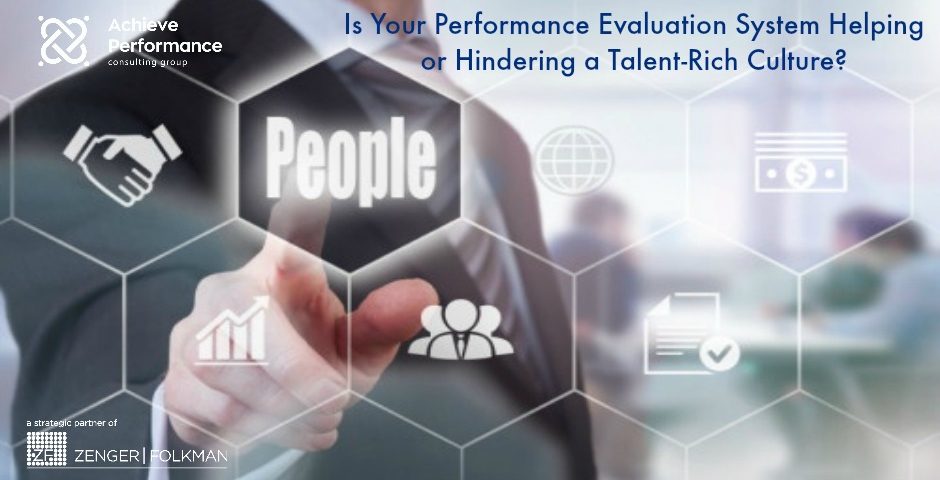Is Your Performance Evaluation System Helping or Hindering a Talent-Rich Culture?

5 keys to unleash post merger sales synergies

Coaching—#1 Leadership Behavior

Businessman pressing a People concept button.

Is Your Performance Evaluation System Helping or Hindering a Talent-Rich Culture?
Twelve Steps to Support a Talent-Rich Culture and Drive Performance Excellence
Process versus the People
Are your year-end performance discussions more painful than they’re worth? Are you doing them merely to comply with legal requirements or to decide who gets paid what? Would most of your managers prefer to throw the system out? If so, you are missing the mark on a very powerful system that can build your brand as a talent-based culture and market leader.
Leaders need to ensure they build a culture rich in talent—so rich that their company becomes branded as a great place to build a career, and thus a market leader for top talent. In addition to talent, a positive culture has been proven as a critical competitive advantage. Human resource systems need to be aligned to ensure it supports, and does not destroy, a positive culture.
Of late, performance management systems have come under attack as a “value buster” rather than a “value creator”. As we researched performance management systems in more than 500 Fortune 1000 companies and talked with HR leaders in more than 60 of them, we discovered that the process was often considered more important than the outcome. Checking the box once a year to make sure the employee and manager had at least one performance discussion seemed to be the prevailing outcome achieved. Other leaders mainly focused on compensation alignment. Few focused on creating a system where employees and their managers truly had a dialogue that actually helped employees understand how they could continue to grow and improve. To quote several senior HR leaders, “We are highly tactical in our approach and we don’t really use [performance discussions] to drive alignment to our culture and to our overall business strategy.”
Shouldn’t the purpose of performance discussions be about excellence in how everyone performs as it aligns with the organization’s culture and business strategy? What needs to be done to get it right?
12 Steps to Getting it Right
Here are 12 proven steps that everyone can use to support a talent-rich culture and drive performance excellence:
1. Be crystal clear on the purpose of your performance system. What is the “people” philosophy that you are trying to promote through this system?
2. Ensure that the system aligns with your organization’s values. Make sure that these values are discussed so that everyone understands that what is done is as important as how it’s done.
3. Create a working profile of what the values look like in action. State the values in terms of behaviors that everyone can recognize. This way, everyone in the organization understands the standard of “the best.”
4. Train all leaders and managers to recognize great behavior, assess talent, and provide specific and actionable feedback.
5. Teach managers and leaders how to effectively coach. Agree on a coaching model and consistently apply it throughout the organization.
6.Create peer coaching circles to help team members support each other in learning new skills and “grooving” new behaviors. These circles enable employees to learn to ask each other for help when they need it, and share suggestions and ideas.2
7. Create a simple form for year-end performance reviews that is one page—no more than two if you must. Include specific business achievements, behaviors demonstrated, career goals and aspirations and, finally, what the employee needs to do to continue to grow in his or her current role or prepare for the next role. This should be the culmination of all the discussions you have had throughout the year.
8. Don’t just reward for business outcomes; reward for expected behaviors as well.
9. Measure and track the impact the system is having on the desired culture. Examine employee engagement scores to ensure feedback and coaching is happening through the year and measure your alignment with your culture so you don’t lose sight of keeping your values on track.3
10. Link all your talent and performance discussions together to make sure you are sending consistent messages in both the talent discussions and the performance calibration discussions.
11. Discourage having just a once-a-year “feedback” session and focus on what it takes to be successful. Ratings are a distraction from improvement.
12. Communicate, communicate, and communicate more about the impact of an effective system and how it is building a great place to grow your career and achieve both business and personal goals.4
If you follow these 12 steps, you will build a system that becomes part of your organization’s DNA, where people and leaders regularly help each other succeed through effective feedback and coaching. This way, you will be providing performance feedback throughout the year, and the end of the year “pain” goes away! Try it—you might like it.
Read more
Source: Human Synergistics



